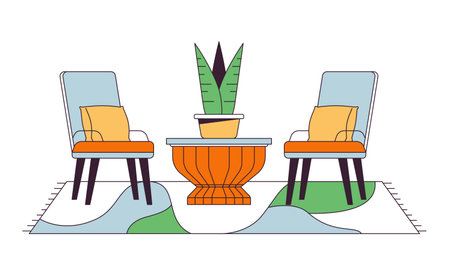Introduction to Vastu Shastra in Modern Indian Offices
Vastu Shastra, the ancient Indian science of architecture, is becoming increasingly relevant in today’s corporate landscape. Rooted in traditional wisdom, Vastu principles offer guidance on spatial arrangement, energy flow, and harmonious design. As more Indian businesses strive to create productive and welcoming environments, the application of Vastu Shastra in office spaces is gaining momentum. A key area where this influence is most visible is the reception zone—the very first point of contact for visitors, clients, and employees alike. In contemporary Indian offices, ensuring that the reception area is Vastu-compliant is considered vital for attracting positive energies, fostering trust, and establishing a balanced workplace atmosphere. By thoughtfully aligning modern space planning with Vastu recommendations, organisations can nurture growth, well-being, and prosperity from the moment anyone steps inside.
2. Key Vastu Guidelines for Reception Area Placement
Designing a reception area in an Indian office is not just about aesthetics; it’s also about harnessing positive energy through Vastu Shastra. Vastu, the ancient Indian science of architecture, offers valuable guidance for positioning and planning your reception space to invite prosperity and harmony into your workplace. Below, we detail essential Vastu principles tailored specifically for Indian office environments.
Fundamental Vastu Directions
According to Vastu Shastra, the orientation of your office and its key elements greatly influences the flow of energy. The main directions to consider are:
| Direction | Vastu Significance | Recommended Usage |
|---|---|---|
| North-East (Ishan) | Promotes positivity, clarity, and growth | Ideal for reception area placement |
| East (Purva) | Symbolizes new beginnings and opportunities | Favorable for entrances and welcoming spaces |
| North (Uttara) | Associated with wealth and career advancement | Good for main entrance or reception desk orientation |
| South or South-West (Dakshin or Nairutya) | Heavy, stable energies; less favorable for entry points | Avoid placing reception here; use for storage or staff areas |
Entrance Placement According to Vastu
The main entrance is considered the mouth of energy in Vastu. Placing the entrance in the North-East, East, or North direction is highly recommended. This invites beneficial energies and makes visitors feel welcome right from the start. Ensure that the entrance is well-lit, uncluttered, and free from obstacles like shoe racks or bins.
Reception Desk Positioning & Staff Orientation
The reception desk should be positioned so that the receptionist faces either East or North while attending visitors. This alignment encourages alertness and positivity. Avoid placing the desk directly opposite the main door—leave some space to buffer direct energy flow. Here’s a quick reference:
| Element | Best Direction/Placement | Key Considerations |
|---|---|---|
| Reception Desk | East or North-facing; not directly aligned with entrance door | Keeps staff energized and attentive; avoids negative energy rushes |
| Sofa/Seating Area | South-East or North-West of the reception zone | Makes guests comfortable and maintains smooth movement flow |
| Cubboards/Storage Units | South-West corner of reception area if needed | Keeps heavy items stable and out of sight from visitors |
Decor Elements as per Indian Culture & Vastu Shastra
Select decor that resonates with Indian values and enhances Vastu compliance:
- Potted plants: Place green plants in the North or East to attract freshness—avoid thorny species.
- Auspicious symbols: Hang traditional Swastika, Om, or Ganesha motifs at the entrance for blessings.
- Aquariums/fountains: If space allows, install a small water feature in the North-East to promote peace and abundance.
- Avoid mirrors facing entrance: Mirrors reflecting the main door are believed to deflect positive energy back outside.
Culturally Sensitive Touches for Indian Offices
Add local crafts or artwork celebrating India’s rich heritage. Use warm lighting and keep incense sticks handy for festive occasions—these subtle details reinforce hospitality and positive vibes in line with Indian customs.
Your Reception: A Gateway to Prosperity & Harmony
The careful application of these key Vastu guidelines will ensure your office’s reception area not only impresses visitors but also becomes a source of lasting success and wellbeing for your entire team.

3. Choosing Auspicious Colours and Décor for Reception
Creating a Vastu-compliant reception area in your Indian office goes beyond just spatial arrangement—it extends to the colours, artwork, and décor that you choose. These elements play a vital role in setting a positive tone and making guests, clients, and staff feel truly welcomed. Here are some practical tips to guide your choices while honouring both Vastu principles and Indian aesthetics.
Selecting Auspicious Colours
According to Vastu Shastra, colours have significant influence on energy and mood. For an office reception, earthy shades like light yellow, beige, cream, or soft green are considered highly auspicious. These hues invoke feelings of warmth, prosperity, and harmony. Avoid using dark or aggressive colours such as deep red or black in this space, as they can create heaviness or negativity. Instead, opt for calming tones that reflect India’s rich natural palette—think marigold yellows or peacock blues in accent details.
Choosing Culturally Resonant Art
Art has the power to communicate your company values and cultural roots at first glance. Display paintings or sculptures that depict traditional Indian motifs such as lotus flowers, elephants (a symbol of good luck), or abstract art inspired by local craftsmanship. Ensure that any religious symbols are respectful and placed according to Vastu—for example, images of deities should face the entrance only if appropriate for your workplace culture.
Decorative Elements That Welcome
Vastu recommends incorporating natural elements wherever possible. Place fresh flowers or a small water feature near the entrance to invite positive energy. Brass lamps, terracotta pots, or handwoven rugs add both aesthetic charm and cultural resonance. Keep the décor uncluttered—a tidy space is essential for good energy flow.
Tips for a Harmonious Reception Ambience
- Use mirrors strategically to expand light and openness but avoid placing them directly opposite the main door.
- Avoid artificial plants and dry flowers; real greenery is always preferable for attracting positive vibes.
- Consider subtle incense or a diya lamp during special occasions to evoke auspiciousness without overwhelming visitors.
Final Thought
A thoughtfully designed reception area, guided by Vastu-compliant colours and décor choices rooted in Indian culture, ensures every guest feels instantly at home and enveloped in positivity from the very first step inside your office.
4. Optimizing Natural Light and Energy Flow
In Indian office space planning, optimizing natural light and ensuring smooth energy flow is central to creating a Vastu-compliant reception area. The reception is the first touchpoint for visitors and employees, making it crucial for positive impressions and productivity. Vastu Shastra emphasizes the importance of sunlight, air circulation, and harmonious energy for both physical comfort and spiritual well-being.
Maximizing Natural Light
According to Vastu, the North-East direction is considered auspicious for receiving maximum morning sunlight, which brings positivity and freshness into the space. Place large windows or glass doors in this direction whenever possible. Use light-colored curtains or blinds that allow sunlight to filter through without causing glare. Consider using reflective surfaces like mirrors on the North or East walls to enhance natural brightness throughout the reception area.
Ensuring Proper Airflow
Good ventilation is key for health and a vibrant environment. Keep the pathway from the main entrance to the reception desk clear of obstructions to facilitate free movement of air and energy (prana). Install ceiling fans or air purifiers if needed, but avoid placing them directly above the main seating area as per Vastu guidelines.
Table: Practical Tips for Light & Air Optimization
| Element | Vastu Direction | Practical Tip |
|---|---|---|
| Windows | North-East/East | Add large windows or glass panels for natural light |
| Reception Desk Placement | South-West/North-West | Avoid blocking light sources; keep desk away from direct draft |
| Airflow Pathway | Main Entrance to Reception | Keep passage clear of furniture and clutter |
| Decor Items (Plants, Water Elements) | North/East/North-East | Use indoor plants or water bowls to refresh air and energy |
| Reflective Surfaces | North/East walls | Add mirrors or glossy decor to amplify brightness |
Harmonizing Energy Flow for Productivity & Impressions
A balanced reception area uplifts moods and supports productive work culture. Avoid dark corners by using soft lighting in the evenings. Ensure there are no sharp edges on furniture pointing towards the entrance, as they can disrupt energy harmony. Subtle fragrances like sandalwood or jasmine can be used to create a welcoming ambience in line with Indian traditions.
Cultural Touch: A Warm Welcome with Positive Energy
The Indian tradition of greeting guests with warmth can be enhanced by placing a traditional rangoli at the entrance or displaying auspicious symbols like Om or Swastika near the reception desk. These not only align with Vastu principles but also make visitors feel valued right from their first step inside.
5. Integrating Traditional Aesthetics with Modern Functionality
When designing a Vastu-compliant reception area for an Indian office, it is both practical and heartwarming to blend the timeless beauty of traditional Indian elements with the efficiency of modern layouts. This not only creates a welcoming atmosphere but also respects cultural values and spiritual well-being. Here are some thoughtful ideas to help you create a reception space that is both stunning and functional, all while staying true to Vastu principles.
Incorporate Indian Motifs in Contemporary Design
Consider using classic Indian patterns like paisleys, mandalas, or lotus designs as subtle accents on feature walls, furniture, or even flooring tiles. These motifs can be laser-etched onto glass partitions or printed on reception desk panels for a touch of tradition without overwhelming the space. Select geometric arrangements that align with Vastu directions to channel positive energy.
Choose Authentic Materials with Modern Finishes
Marble, wood, and brass have long been staples in Indian interiors. For your reception, opt for a sleek marble counter or wooden wall paneling finished in minimalist lines. Brass inlays on handles or decorative trims can evoke luxury while maintaining simplicity. Ensure that these materials are placed according to Vastu guidelines—for example, wood in the east and marble in the north—to maximize harmony.
Weave Spiritual Symbols into Everyday Design
Placing a small idol of Ganesha or a framed Om symbol at the entrance can infuse the area with positivity and protection. These sacred icons should be positioned on the northeast side of the reception, as recommended by Vastu. You might also use rangoli-inspired floor tiles or hang torans (traditional decorative garlands) above doorways for an auspicious welcome that blends seamlessly with modern aesthetics.
Balance Light and Space Thoughtfully
Natural light is highly valued in both Vastu and contemporary design. Use sheer drapes or frosted glass to allow sunlight to flow in while ensuring privacy. Modern LED lighting fixtures can be chosen in warm tones to mimic traditional oil lamps, creating a serene ambiance. Arrange seating so that guests face east or north—directions favored by Vastu for positive interactions.
Create a Sense of Belonging and Efficiency
The integration of Indian traditions into modern reception spaces does more than honor heritage—it fosters comfort and belonging among clients and staff alike. By blending spiritual symbols, indigenous materials, and time-honored motifs within practical layouts, you ensure your office reception is not just functional but also deeply rooted in Indias rich cultural tapestry—all while adhering to Vastus guidance for prosperity and peace.
6. Common Vastu Mistakes and How to Avoid Them
Frequent Vastu Errors in Indian Office Receptions
While planning the reception area of an Indian office, it is common to unknowingly make Vastu-related mistakes that can impact the overall energy and prosperity of the workspace. Here are some frequent errors:
- Reception Desk Placement in the South or South-West: Placing the main desk in these directions may create obstacles in business growth and hinder opportunities.
- Entrance Door Facing Inauspicious Direction: If the main entrance is not facing North or East, positive energy flow can be restricted.
- Cluttered Reception Area: Accumulated files, unnecessary furniture, or decor items block good vibes and create a feeling of chaos.
- Lack of Natural Light: Dark and poorly lit receptions reduce positivity and may affect staff morale.
- Sitting with Back to Main Door: The receptionist sitting with their back towards the entrance is considered inauspicious as it blocks support from clients and benefactors.
- Improper Use of Colours: Using dull or dark colours instead of recommended shades like light green, blue, or white can dampen vibrancy and productivity.
How to Correct These Mistakes
- Optimal Desk Placement: Position the reception desk facing North or East. The receptionist should sit so they face either direction while welcoming visitors.
- Main Entrance Alignment: If possible, ensure your reception entrance faces North or East. Otherwise, enhance the entryway with auspicious symbols like Swastika, Om, or fresh flowers for positive vibes.
- Declutter Regularly: Maintain a clean and organized reception. Avoid storing old files or broken electronics here. Simplicity attracts prosperity.
- Add Natural Light: Maximize sunlight by keeping windows unobstructed and using light curtains. Supplement with bright lighting fixtures if natural light is limited.
- Seating Arrangement: Always have the receptionist face visitors head-on, preferably with a solid wall behind them for support. Avoid having their back to any entryway.
- Select Vastu-Friendly Colours: Choose pastel shades, soft blues, greens, or whites for walls and décor to boost calmness and energy flow.
The Indian Context: A Gentle Reminder
Respecting Vastu principles is not just about tradition; it’s about fostering a harmonious environment that welcomes success and well-being. By avoiding these common mistakes and making small adjustments, your office reception can become an inviting gateway for growth—reflecting both Indian values and modern professionalism.
7. Conclusion: The Right Beginning for Success
In Indian office culture, the reception area is much more than a place to welcome visitors—it is the energetic gateway that sets the mood for the entire workspace. Adhering to Vastu principles when planning your office’s entrance and reception not only honors traditional wisdom but also creates an environment where positivity, harmony, and prosperity can flourish. A Vastu-compliant reception area ensures that first impressions are infused with warmth and auspiciousness, sending out subtle signals of trust and success to clients, employees, and business partners alike. By thoughtfully integrating elements such as proper orientation, natural lighting, and symbolic décor rooted in Indian tradition, offices can cultivate an atmosphere where everyone feels welcomed and energized from the very first step inside. Ultimately, investing care in space planning according to Vastu is not just about design; it’s about laying a strong foundation for growth, unity, and ongoing achievement in every Indian workplace.


